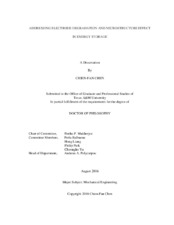| dc.description.abstract | Recent years have witnessed a phenomenal increase in research efforts in energy storage for vehicle electrification. Lithium batteries, such as lithium-ion and lithium-sulfur batteries are leading the race towards meeting the energy and power requirements for the next generation of hybrid and electric vehicles. Majority of the research focused on the performance improvement and degradation analysis of lithium batteries. Since the electrode microstructure affects the electrode properties, such as effective ionic conductivity and solid-phase diffusion, the cell performance and degradation phenomena (i.e. formation microcrack and solid electrolyte interphase) vary with the microstructure design. The objective of this dissertation is to develop a microstructure-aware electrochemical model to conduct a fundament study of microstructural effects on cell performance and degradation. The influence of microstructure was observed from the cell performance and electrochemical impedance spectroscopy (EIS).
In the study of lithium-ion batteries, the proposed model successfully captures the influence of active particle morphology on the SEI formation and corresponding impedance characteristics. Different electrode realizations with microstructural and compositional variations have been considered. The critical influence of active material morphology, mean particle size, binder and electrolyte volume fractions on the SEI formation and impedance behavior reveals the underlying interdependences of the interfacial and transport resistance modes. Moreover, a systematic investigation of the influence of mechanical degradation on the resistance to diffusion and charge transport is provided. In this regard, a modeling approach combining fracture formation and electrochemical impedance is presented, which predicts the mechanical damage induced impedance response and resistance evolution in the electrode. Besides the degradation phenomena, the microstructure-aware electrochemical model also captures the microstructural effects on the heat generation and electrode optimization design. With this model, the electrode microstructure has been proven to have an influence on the cell temperature under different discharge rate and ambient temperature. The variation of cell temperature has been analyzed and discussed by the time evolution and spatial distribution of different heating sources (i.e. joule heating, reaction heating, and reversible heating).
In the study of lithium-sulfur batteries, due to the influence on precipitation, the degradation of lithium-sulfur batteries can be controlled by the electrode microstructure fabrication. A microstructure-aware impedance model is proposed to observe the microstructure evolution and the influence of microstructure on the impedance response. The microstructure-aware impedance model adopted the method of three-dimension (3D) virtual microstructure reconstruction to take the varied microstructure properties (due to precipitation or solid sulfur loading), such as porosity, tortuosity, and interfacial electrochemical area, into account. Besides the properties required for the impedance prediction, the pore-size distribution, transport path, and pore closure were also observed and discussed from the reconstructed microstructure. According to the prediction of impedance response, the impedance evolution during the discharging process can be detail addressed and a strategy of electrode microstructure design is proposed. | en |


